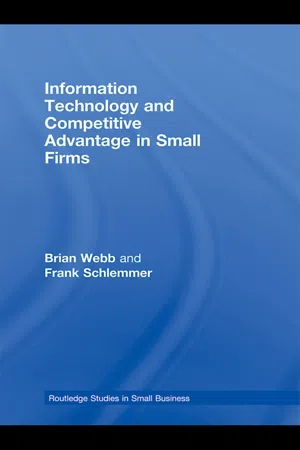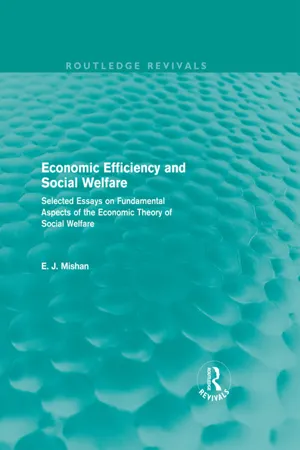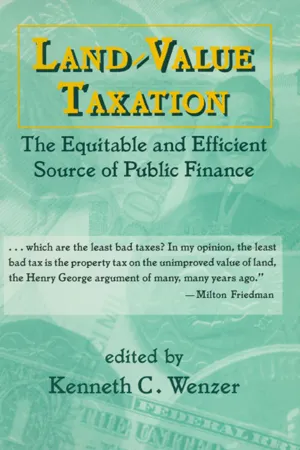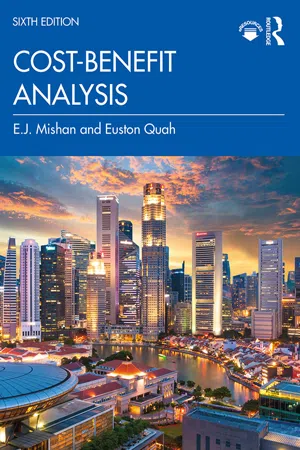Economic Rent
Economic rent refers to the payment made for the use of a resource that exceeds the minimum amount required to keep the resource in its current use. It is the surplus income earned by a factor of production beyond what is needed to keep it in its current use. In business, economic rent can arise from factors like location, natural resource availability, or unique skills.
7 Key excerpts on "Economic Rent"
- Brian Webb, Frank Schlemmer(Authors)
- 2008(Publication Date)
- Routledge(Publisher)
...Any factor (land, labour or capital) which is insufficiently rewarded in its present occupation will move to seek out a better reward elsewhere. To keep a factor employed in its current occupation it must earn (or be rewarded with) an amount at least equal to its ‘transfer earnings’. Transfer earnings are the amount the factor would earn in its best paid alternative employment. This amount is also known as the factor’s ‘opportunity cost’. So Economic Rent is the payment to a factor over and above what is necessary to keep that factor in its current employment (that is, a payment to a factor less its opportunity or transfer cost). This definition of Economic Rents illustrates two important aspects about the study of competitive advantage. First, the definition of competitive advantage determines what is measured and the outcomes of the study. Second, it determines the difference between accounting measures of profit and economic measures of profit. For accountants, ‘profit’ is the difference between the sale price of a good or service and its cost of production. But economists include also the opportunity cost, or the cost of alternative uses of the factors used to produce that profit. Critically, economists make a distinction between ‘normal profit’ and ‘Economic Rent’. Normal profit is defined as an acceptable or reasonable return on the capital invested in producing that profit. This is the minimum return necessary to continue production, since if a factor of production is not producing a return at least equivalent to what could be earned in alternative employment, then that capital will move elsewhere in pursuit of higher returns. In a perfect market, the free flow of capital will mean that all firms achieve normal profits, and there will be no Economic Rents, which are defined as a return above normal profits, sometimes also known as super-profits. And without Economic Rents no firm can have a competitive advantage. However, markets are not perfect in real life...
- eBook - ePub
Economic Efficiency and Social Welfare (Routledge Revivals)
Selected Essays on Fundamental Aspects of the Economic Theory of Social Welfare
- E. Mishan(Author)
- 2013(Publication Date)
- Routledge(Publisher)
...55 (1965), pp. 395-423. 7 Rent as a Measure of Welfare Change The definitions of Economic Rent in current use fall easily into two categories: (1) a payment in excess of that necessary to maintain a resource in its current occupation. Thus, Frederick Benham 1 tells us that rents are ‘the sums paid to the factors which need not be paid in order to retain the factors in the industry ’. While to Kenneth Boulding 2 it is the payment to a factor ‘in excess of the minimum amount necessary to keep that factor in its present occupation’. The second category (2) is the difference between the current earnings of a resource and its transfer earnings 3 — the latter term signifying its earnings in the next best alternative use 4. For instance, Paul Samuelson 5 says, ‘we should term the excess of his income above the alternative wage he could earn elsewhere as a pure rent ’. Similarly, for George Stigler 6 the rent of a factor is ‘the excess of its return in the best use over its possible return in other uses’. 7 While the first type of definition is, as we shall see, unavoidably ambiguous, the second type is yet more inadequate. Among other things it would require that, in the choice of occupation, men were motivated solely by pecuniary considerations. I A Measure of Rent as an Economic Surplus For the purpose of revealing ambiguities in the existing definitions of Economic Rent and of demonstrating the logic of the proposed definition, we shall find it no less convenient and a good deal more suggestive to take our bearings from a more generalized version of the traditional theory of consumer’s choice. Rather than maximizing the utility function W[u(x 1,…, x n ], over the range in which ∂ W /∂ x r > 0 for all x r subject to the usual constraint Σ; p r x r = Y where Y is the individual’s income, 8 we require our individual, in possession of given resources, or assets, to maximize such a function subject to Σ p r x r = 0...
- eBook - ePub
Land-Value Taxation
The Equitable Source of Public Finance
- K.C. Wenzer(Author)
- 2016(Publication Date)
- Routledge(Publisher)
...14 Fred E. Foldvary The Ethics of Rent Rent is a source of public revenue that does not engender any economic damage. But is it morally right to take revenue for government from only one class of owners? And is there a conflict or is there harmony between what is morally right and what is economically sound? What Rent Is The term “rent” has several meanings. The classical meaning is the return on land as a factor or resource of production. Since it was recognized that landowners as landowners receive rent without having to do anything for it but have title to land, the term became extended to “Economic Rent,” meaning any income beyond that which is needed to put a factor into production. More recently, the term “rent seeking” was introduced to mean the Economic Rents taken by whoever receives government privileges, subsidies, and other transfers. 1 Popularly, “rent” also means a payment for the use of property owned by others, as in renting a car or apartment; a synonym for this meaning is “rental.” Unless otherwise qualified, the term “rent” in this chapter refers specifically to land rent. “Economic Rent” will take the definition just given, and “rental” will refer to payments for the use of any property and (as discussed below) to land rent due to the presence of public or civic works. “Land” in economics includes all natural resources, everything prior to alteration by human action. The narrower meaning is the solid surface of the earth. Here, “land” will refer to economic land, which embraces all natural resources and opportunities, including those not traditionally associated with land...
...Whereas rent in the former sense hinges upon the commodity as its basis, the latter concept of Economic Rent, coming out of neoclassical theory but also deployed in heterodox approaches such as with technoscience rent, is agnostic about its material tether and more dependent on the degree of competition in the market in which it is exchanged. Economic Rent is therefore a function of competition while rent is considered a function of commodities. The various forms of rent discussed thus far might be considered as nodes along the arc of a pendulum with its points of reflux at commodity and competition. Figure 4.2 below visualizes what this arc might look like. Figure 4.2 Commodity-based rent refers to the fact that the rental payment for the use of a resource is a function of the commodity. The commodity in this context refers to property, a thing, tangible or not, that is produced and that someone possesses, within the context of a system of property rights. The basis of rent for this commodity is its material character but the reason that it produces rent for its owner at all is due to the system of property rights within which its ownership, control, exchange and consumption is determined. This is why ‘commodity’ is the most appropriate descriptor for this category of rent, rather than say ‘property’ or ‘asset’, 18 because the commodity encompasses both the materiality of the thing and its cocoon of property rights which are historically specific. Competition-based rent refers to what is known in the mainstream as Economic Rent. It is tethered to competition because the rental payment in this case derives from the degree of competition in the market where the factor of production in question is purchased. Competition is preferred to market as a descriptor for this type of rent because the rent arises within a market but only insofar as it is a function of the degree of competition present...
- eBook - ePub
Rent Control in North America and Four European Countries
Regulation and the Rental Housing Market
- William Smith, Michael Teitz(Authors)
- 2020(Publication Date)
- Routledge(Publisher)
...Growth controls, for example, drive up land and housing prices, and they make it difficult for developers to expand housing supply. As demand for housing grows, while the stock adjustments are impaired by policy, Economic Rents are generated and reaped by all property owners within the urban boundaries. Rent controls may be introduced in such situations to help reduce the extent of the redistributions created by the side effects of growth control policy. This type of rationale, however, is generally disliked by economists, who see its use as a justification of ever increasing interference by governments into market processes. Redistribution of Economic Rents An economic rationale for regulation is sometimes called “rent control,” though it is not specifically related to housing, but refers instead to the existence of Economic Rents. In this sense, rent refers broadly to the benefit that accrues to any firm that is able to produce a commodity at a cost that is below the going market price and sustain that advantage against competing firms. For example, a mineral producer owning a deposit that is well located, rich, and easily worked will have a cost advantage against other producers with inferior deposits, and will therefore be able to gain “above normal” profits. If increasing demand for the product bids up the price for all producers, then the low-cost firm will gamer Economic Rent in addition to its “normal” profit. 4 Strictly speaking, within the argument of neoclassical economics, there is no justification for regulating such rents. They may be arbitrary, depending upon the good fortune of the producer, or they may be attributable to superior business or technical acumen. 5 But in either case, the Economic Rents do not affect the efficiency of the resulting pattern of production. Indeed, any attempt to control them may give rise to resource misallocation that prevents the market from moving in a way that will eliminate them if it is technologically possible...
- eBook - ePub
- E.J. Mishan, Euston Quah(Authors)
- 2020(Publication Date)
- Routledge(Publisher)
...Appendix 6 The concept and measure of rent 1 Although the concept of rent, in the specific sense of a surplus to factor-owners, is not so popular in CBAs as the concept of consumers’ surplus, it is possible that, with growing awareness of allocation theory and growing refinements in techniques of measurement, it will become increasingly employed. The concept deserves more detailed treatment for another reason: the use of the area above the supply price of a factor is a less reliable proxy for the measurement of rent than is the area below the consumer’s demand curve a proxy for his surplus. The reader will appreciate this remark more readily after the concept of rent has been defined. Textbook definitions that are still in current use can be divided into two types. One conceives of rent as a payment in excess of that necessary to maintain a factor in its current occupation. The other would describe it as the difference between the factor’s current earnings and its ‘transfer earnings’ – the latter term denoting its earnings in the next most highly paid use. As we shall see, the first type of definition is ambiguous because of the quantity constraint. The second type of definition is even more restricted, however, as its validity would require that, in the choice of occupation, men are motivated solely by pecuniary considerations. Indeed, it will transpire that, like consumer surplus, rent is a measure of change in a person’s welfare and, again like consumer surplus, can have both a CV and an EV measure. 1 2 As with the treatment of consumer surplus, our first recourse will be to the indifference map. Figure A6.1 indicates four quadrants of a diagram in which money income Y is again measured vertically, and the good L (which can be thought of as labour services) is measured horizontally...
- eBook - ePub
- Martin Bronfenbrenner(Author)
- 2017(Publication Date)
- Routledge(Publisher)
...When the going rental rises for reasons unconnected with potato growing, the higher rent is a price-determining cost on the same footing with wages or interest. At the macroeconomic level, the case becomes different. The flow of services developed from the constant stock of agricultural land to farming as a whole, approximates the vertical line C (Fig. 14.1), except in the neighborhood of reclamation projects (drainage, irrigation, etc.) and suburban sprawl. Its rent is fixed entirely by demand considerations, direct and indirect (v.m.p.), if we treat its supply function as reservation demand à la Wicksteed. Abstracting from both technical change and non-agricultural demand, an increase in the demand for farming land arises from an increase in some index of agricultural prices. Two likely causes for such increase are prosperity and population growth; a third, where the farm bloc has political potency, is a shift in agricultural controls in favor of farmers. Rent is a price-determined cost in the absence of technical change and nonagricultural demand for land; and Ricardo was largely right on his own terms, which, as Buchanan argues, involved the use of “corn” to mean not merely wheat but agricultural produce in general. This is Buchanan’s solution for Davenport’s celebrated general-equilibrium paradox in verse, which made better American economics than English poetry: 11 The price of pig is something big, And likewise corn, you’ll understand, Is costly too, because they grew Upon the high-priced farming land. If you’d know why that land is high, Consider this: its price is big Because it pays thereon to raise The costly corn, the high-priced pig. Land-Value Taxation 8. “Rent is an economic surplus and an unearned increment, and therefore a fitting object for differential taxation.” The argument is familiar...






